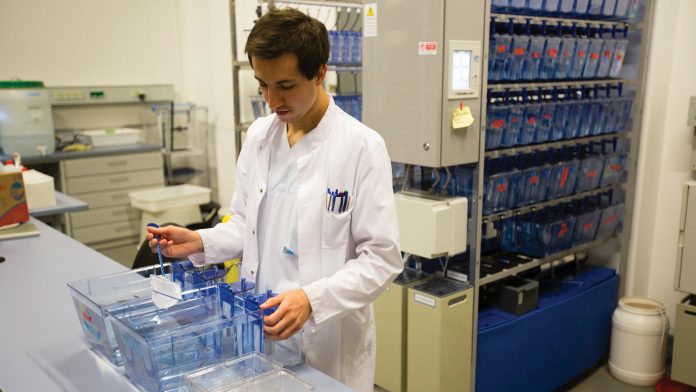
Discover more about the collaborative research from Germany that sheds new light on the genetic basis behind congenital heart defects.
Using state-of-the-art gene analysis methods, a German team of researchers was able to show that a complex congenital heart defect originates in several genes and how these genetic alterations interact.
For many years, the team investigated a 19-person family in which 12 people were affected by a particular genetic alteration.
What are heart malformations?
Congenital heart defects are the most common organ malformations and occur in about 1% of new-borns. The malformations of the heart can be treated better and better, which is why those affected increasingly decide to start a family themselves. For this reason, physicians and biologists are more interested in the molecular causes of these diseases in order to improve the therapeutic and diagnostic possibilities.
A large number of genes are involved in heart malformations. Only a small number of these diseases are caused by mutations in individual genes, so-called ‘monogenic mutations’. A gene is a sequence of codes in the genetic material DNA that contains the blueprint for a protein.
It can be assumed that numerous congenital heart diseases are caused by the simultaneous occurrence of mutations in different genes. One of the most urgent challenges in the search for the causes of congenital heart defects is therefore to better understand the interaction of these multiple gene mutations.
What do you know about congenital heart defects?
A congenital heart defect is a malformation of the heart or the large vessels. It is called a ‘defect’ because a defect ‘happens’ during embryonic development of the heart and its vessels during the first weeks of pregnancy. The causes for the errors in heart development are very diverse.
There are no single causes, but a lot of causes have to come together so that the heart development is disturbed. Unfortunately, so little is still known about this that these errors cannot be avoided.
Congenital heart defects are the most common congenital defects that occur in humans. Approximately every 100th child is born with a heart defect. In boys, heart defects occur somewhat more often.
The frequency with which individual heart defects occur is very different. There are both simple heart defects and severe heart defects, which occur frequently, but also mild and severe heart defects, which occur very rarely.
What did the research find?
The research team from Germany was able to show that family investigations using the latest DNA sequencing technology are suitable for identifying complex, i.e. multigenic, causes. They then modelled these genetic changes in zebrafish and were able to show how they affect the heart.
The participating scientists from the University Hospital Hamburg-Eppendorf, the Hanover Medical School, the German Heart Centre Munich, the University of Göttingen, the University of Lübeck and the University of Potsdam presented the sequencing data of a family with different complex congenital heart defects, including Ebstein anomaly, atrioventricular septal defect and others.
A total of 12 of 19 family members carry a family-specific mutation in the BMPR1A gene on chromosome 10. This mutation is associated with a previously unknown mutation within a region of chromosome 1 and leads to the development of these severe heart abnormalities.
The receptor protein BMPR1A and its ligands are involved in the transmission of chemical signals from the cell membrane to the nucleus and thus regulate cell growth and division as well as the activity of certain genes.
In zebrafish, it has now been shown that the continuous overexpression of the human BMPR1A mutation in the zebrafish heart is associated with the development of smaller heart valves, leads to the down-regulation of the Wnt/ß-catenin signalling pathway, which is so important for heart development, and also causes tissue proliferation at the heart valves in the zebrafish heart. This is a sign that BMPR1A is involved in heart development.
More about the zebrafish
The zebrafish is an excellent animal model for studying heart development as it is a vertebrate like humans and therefore has a cardiovascular system very similar to ours.
Although the zebrafish belongs to the genus of fish, its genetic code is very similar to that of humans. It is also transparent, and its development takes place outside the mother’s body. A beating heart can be seen in the zebrafish embryo only 24 hours after egg deposition.
In experimental studies, zebrafish genes can be manipulated to investigate the effect on heart development. The function of the heart can be tested in the same way as in humans. In the two-day-old zebrafish embryo, this is done using a high-speed camera; in adult fish, it is done using a cardiac ultrasound examination.
What next?
This finding now opens up the possibility of testing the genetic interactions between BMPR1A and other candidate genes within the region on chromosome 1 and thus detecting more complex genetic causes of congenital heart defects.
Professor Jeanette Erdmann explains: “The study is also a prime example of endurance in research because the beginnings date back to 1996 when the first patient from the family came to the University Hospital in Regensburg. Only the rapid technological development in recent years, in particular the so-called ‘next-generation sequencing’ method, has enabled the study to be completed positively. In addition, the patience of the family was of course ‘indispensable’.”
Professor Salim Seyfried adds: “The zebrafish studies were ultimately decisive in proving the disease relevance of the candidate mutation. This DZHK-sponsored collaboration proves how important the co-operation of working groups with different expertise has become for
modern biomedicine.”
In recent years, the project has been funded by the REBIRTH Excellence Cluster, the DZHK e.V., the University of Lübeck, the German Heart Foundation and the DFG.
References
Professor Dr Jeanette Erdmann
Institute for Cardiogenetics
University of Lübeck
+49 (0)451 3101 8300
jeanette.erdmann@uni-luebeck.de
https://cardiogenetics-luebeck.de
Please note, this article will appear in issue 9 of Health Europa Quarterly, which is available to read now.






















